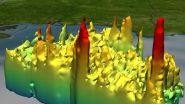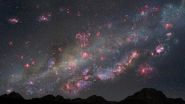(Press-News.org) COLUMBUS, Ohio--A new study provides an inside look at the most powerful explosions in the universe: gamma-ray bursts.
These rare explosions happen when extremely massive stars go supernova. The stars' strong magnetic fields channel most of the explosion's energy into two powerful plasma jets, one at each magnetic pole. The jets spray energetic particles for light-years in both directions, at close to light speed.
On Earth, we detect bits of the resulting debris as gamma rays. Researchers also suspect--but haven't been able to prove conclusively--that GRBs are the source of at least some of the cosmic rays and neutrinos that pepper our planet from space.
Now, physicists at The Ohio State University and their colleagues have begun to answer that question. By building some of the most detailed computer simulations ever made of a GRB jet's internal structure, they have been able to model particle production inside of it.
Their finding--that the non-uniform internal structure of the jets is key to determining the emission of the different kinds of astroparticles--appears online April 10 in the journal Nature Communications. The study also raises new questions that can be answered only by the next generation of neutrino telescopes.
Mauricio Bustamante, a Fellow of the Center for Cosmology and AstroParticle Physics at Ohio State, explained that the new computer model is a natural outgrowth of recent findings in astroparticle physics, such as the first confirmed cosmic neutrinos detected at the IceCube Neutrino Observatory at the South Pole in 2013.
"Previously, the details of the non-uniformity of the GRB jets were not too important in our models, and that was a totally valid assumption--up until IceCube saw the first cosmic neutrinos a couple of years ago," he said. "Now that we have seen them, we can start excluding some of our initial predictions, and we decided to go one step further and do this more complex analysis."
With partners at Penn State and the DESY national research center in Germany, Bustamante wrote new computer code to take into account the shock waves that are likely to occur within the jets. They simulated what would happen when blobs of plasma in the jets collided, and calculated the particle production in each region.
In their model, some regions of the jet are denser than others, and some plasma blobs travel faster than others.
Bustamante offered the analogy of the plasma jet as a long highway, albeit one where the cars are traveling at different speeds close to the speed of light.
"Everywhere on the highway there are fast-moving cars, but some of them will be fast sports cars, while others will be extra-fast Formula 1 racers. They will collide all over the highway, and when they do they will create debris. The debris always contains neutrinos, cosmic rays and gamma rays, but, depending on where the collisions occurred, one of these will typically dominate the emission," he said.
"If the cars collide close to the beginning of the highway, where the concentration of cars is higher, the debris will be mostly neutrinos. As they race along the highway, the concentration of cars goes down, and so when a collision occurs halfway through the length of the highway, the debris will be mostly cosmic rays. Further down the road, the concentration is even lower, and the gamma rays that we observe at Earth are produced in the collisions at this stage."
The amount of debris that reaches Earth depends on how energetic the star is and how far away it is.
One implication of the model is that the rate of neutrino production in GRBs might be lower than previously thought, so only a minimal number--say, 10 percent--of neutrinos detected on Earth are likely to come from GRBs. The density of neutrinos that reach Earth is called the neutrino flux, and the model predicts that the likely neutrino flux from GRBs is below the threshold of detection for today's neutrino telescopes.
"We expect that the next generation of neutrino telescopes, such as IceCube-Gen-2, will be sensitive to this minimal flux that we're predicting," Bustamante said. Then astrophysicists can use the model to refine notions of GRB internal structure and better understand the sources of cosmic particles detected on Earth.
INFORMATION:
Co-authors on the paper were Philipp Baerwald and Kohta Murase of the Institute for Gravitation and the Cosmos at Penn State and Walter Winter of DESY in Germany.
This work was funded by NASA, the German Research Foundation, and the U.S. National Science Foundation.
Contact: Mauricio Bustamante, (614) 292-0734; Bustamanteramirez.1@osu.edu
Written by Pam Frost Gorder, (614) 292-9475; Gorder.1@osu.edu
Scientists from South Carolina's leading public universities--the University of South Carolina and Clemson University--have made a discovery that could dramatically improve the efficiency of batteries and fuel cells.
The research, which is published in the journal Nature Communications, involves improving the transport of oxygen ions, a key component in converting chemical reactions into electricity. The team studied a well-known material, gadolinium doped ceria (GDC), which transports oxygen ions and is currently in use as a solid oxide fuel cell electrolyte. Through ...
Washington, DC (April 10, 2015) - Using tech, like iPads, in schools has turned into a heated political debate. Los Angeles infamously spent $1.3 billion on a program to give iPads to each student that has subsequently been plagued with problems. In the United Kingdom the head of the National Association of Head Teachers claimed he was dubious about using tech as a teaching aid in non-IT classes. One solution could be using shared tech in classrooms. A promising study by a researcher at Northwestern University found that kindergartners in classes with shared iPads significantly ...
In 1997 when the Tropical Rainfall Measuring Mission, or TRMM, was launched, its mission was scheduled to last just a few years. Now, 17 years later, the TRMM mission has come to an end. NASA and the Japan Aerospace Exploration Agency (JAXA) stopped TRMM's science operations and data collection on April 8 after the spacecraft depleted its fuel reserves.
TRMM observed rainfall rates over the tropics and subtropics, where two-thirds of the world's rainfall occurs. TRMM carried the first precipitation radar flown in space, which returned data that were made into 3-D imagery, ...
In one of the most comprehensive multi-observatory galaxy surveys yet, astronomers find that galaxies like our Milky Way underwent a stellar "baby boom," churning out stars at a prodigious rate, about 30 times faster than today.
Our sun, however, is a late "boomer." The Milky Way's star-birthing frenzy peaked 10 billion years ago, but our sun was late for the party, not forming until roughly 5 billion years ago. By that time the star formation rate in our galaxy had plunged to a trickle.
Missing the party, however, may not have been so bad. The sun's late appearance ...
New evidence published in Science by Smithsonian geologists dates the closure of an ancient seaway at 13 to 15 million years ago and challenges accepted theories about the rise of the Isthmus of Panama and its impact on world climate and animal migrations.
A team analyzed zircon grains from rocks representing an ancient sea and riverbeds in northwestern South America. The team was led by Camilo Montes, former director of the Panama Geology Project at the Smithsonian Tropical Research Institute. He is now at the Universidad de los Andes.
The team's new date for closure ...
New research shows that Lake Erie's dead zones are actually quite active, greatly affecting fish distributions, catch rates and the effectiveness of fishing gear.
Scientists with the U.S. Geological Survey, the Illinois-Indiana Sea Grant and partners recently found that dead zones caused by hypoxia, the depletion of oxygen in water, are unexpectedly variable in Lake Erie, sometimes disappearing and reemerging elsewhere in the matter of hours. They also found that fish like yellow perch cluster at the edges of these areas. The discovery of erratic dead zones can help ...
PITTSBURGH-- Three leading cognitive scientists from Carnegie Mellon University are questioning the gender representation of invited contributors in the special February 2015 issue, "The Changing Face of Cognition," published by the international journal Cognition.
Cognition, a highly regarded scientific journal, publishes theoretical and experimental papers on the study of the mind - a topic that has been a research strength of CMU for decades and that is receiving intense focus through the federal government's BRAIN Initiative.
In an opinion piece to appear in Cognition, ...
A study in the scientific journal BMC Health Services Research shows that early and guideline adherent physical therapy following an initial episode of acute, nonspecific low back pain (LBP) resulted in substantially lower costs and reduced use of health care resources over a 2-year period.
Physical therapist researchers John D. Childs, PT, PhD, et al analyzed 122,723 patients who went to a primary care physician following an initial LBP episode and received physical therapy within 90 days. Of these, 24% (17,175) received early physical therapy (within 14 days) that adhered ...
Getty Images last year created a new online image catalog of women in the workplace - one that countered visual stereotypes on the Internet of moms as frazzled caregivers rather than powerful CEOs.
A new University of Washington study adds to those efforts by assessing how accurately gender representations in online image search results for 45 different occupations match reality.
In a few jobs -- including CEO -- women were significantly underrepresented in Google image search results, the study found, and that can change searchers' worldviews. Across all the professions, ...
PHOENIX, Ariz. -- April 9, 2015 -- Scientists at the Translational Genomics Research Institute (TGen), using state-of-the-art genetic technology, have discovered the likely cause of a child's rare type of severe muscle weakness.
The child was one of six cases in which TGen sequenced -- or decoded -- the genes of patients with Neuromuscular Disease (NMD) and was then able to identify the genetic source, or likely genetic source, of each child's symptoms, according to a study published April 8 in the journal Molecular Genetics & Genomic Medicine.
"In all six cases of ...



